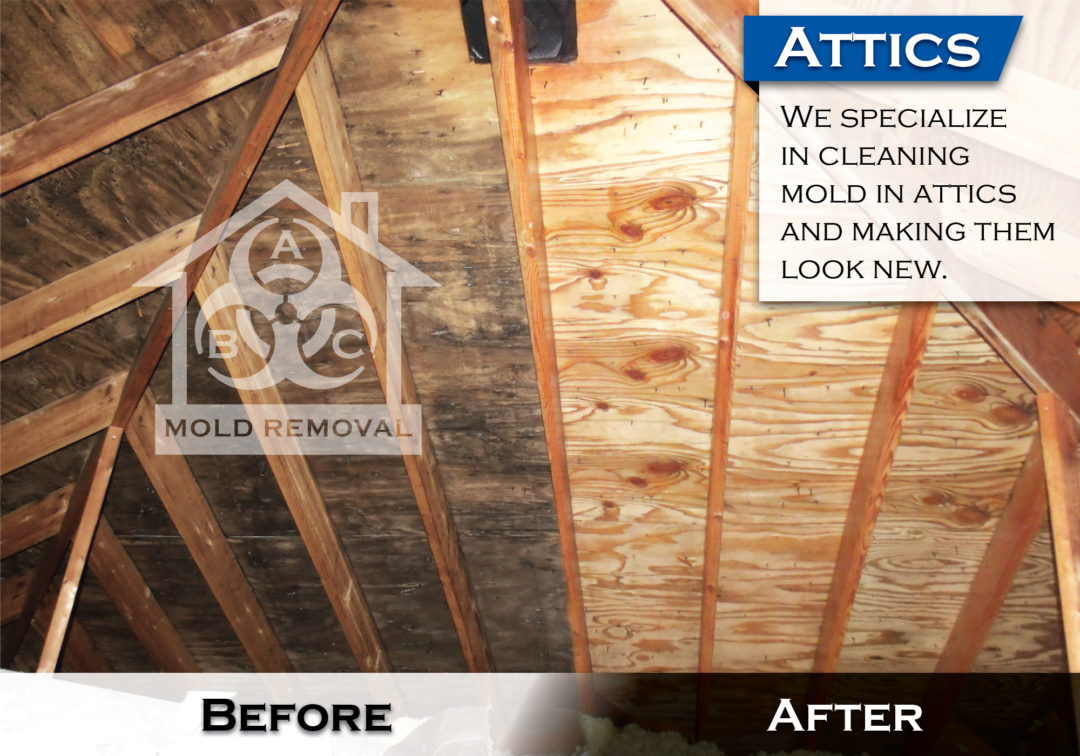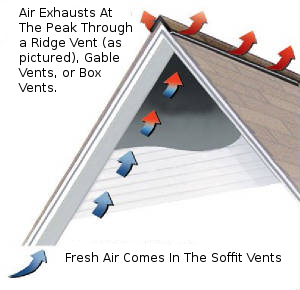
What is "Attic Mold"
"Attic Mold" is a term we use when referring to mold growth in an attic space. It can be any color but most often it shows up black, grey, white or sometimes green usually. Any discoloration can be a good indicator that you might have a mold problem that may need addressed.
Mold growing in the attic is unfortunately very common due to a number of reasons which we'll go over, but It typically starts on the underside of the roof decking and eventually spreads throughout given enough time and moisture if left untreated.
What causes Attic Mold?
Mold in the attic is caused from roof leaks and/or moisture issues. Enough moisture over a period of time can be all that's needed. Sometimes it's from an undiscovered roof leak but most commonly it's ongoing moisture problems, including:
- Poor or Improper attic ventilation
- Inadequate insulation
- Improperly installed bathroom exhaust fans
- "Air Leaks" which are seemingly minor issues like poorly sealed attic doors and hatches or unsealed recessed lighting that can lead to moisture in the attic during colder months from warm air rising up into a cold attic and condensing, which are commonly referred to as "air leaks".
How do you treat Attic Mold?
Our Attic Mold Removal Treatment Process:
- Seal off the affected area to create a contained work space. Containing the affected area is always the first step in proper mold remediation.
- Set up HEPA Air Scrubbers and/or Negative Air Pressure Machines (NAMs) to filter the air in the areas we're working in.
- Use HEPA vacuums on the affected surfaces to help remove microscopic spores and loose particles to prevent further spreading and contamination during the cleaning process.
- Wipe/Scrub the wood with mold stain removers to remove as much of the staining and discoloration as possible. This isn't a required step based on current industry standards because mold staining can exist after a mold problem has been cleaned up properly, but we are able to practically eliminate all mold stains from unfinished wood surfaces which we consider vital to being able to visually assess and determine if a future mold issue re-occurs as early as possible. Some companies just leave the stains and tell you it's dead, while others use paint like coatings called "encapsulants" to cover up the discoloration, possibly preventing you from seeing what's under the surface. We prefer restoring the wood to a like-new appearance.
- Treat surfaces with a Botanical Disinfectant/fungicide to help kill and prevent future regrowth after staining has been removed.
- Final cleanup (wipe and HEPA vac) our way out of the containment.
This is the basic standards of proper mold removal to give you better understanding. There's a little more that goes into every job from the tyvek suits and full face chemical respirators we wear, down to the special equipment we use. While it may sound pretty straightforward, like anything, talking about it and doing it are 2 different things. We always have to be ready to spot hazards and potential complications along the way which is where our 20+ years of experience comes in.
Removing mold from the attic is only part of the process.
To keep it from coming back you need to correct the underlying water/moisture issues that caused the mold to grow to begin with. If you haven't already done so, we can help figure out what most likely caused it in the first place. The usual culprits are what we mentioned above; inadequate or improper ventilation, undetected roof leaks, bathroom exhaust vents that blow into the attic, and condensation from other "air leaks". In most cases, we can provide you with quotes for these repairs as well.
Proper Attic Ventilation

Warm moist air rises and exhausts at the peak while fresh air is pulled in at the base.
A properly ventilated attic space extends the life of your home's roof. Roof ventilation helps remove excess heat and moisture from the attic space so it doesn't build up and cause potentially massive amounts of condensation.
If an attic is not properly ventilated trapped heat and moisture can raise energy costs, cause ice dams, promote the growth of mold and fungi, and cause overall damage to your roof. Condensation inside poorly ventilated attics can be bad enough to be mistaken for a roof leak if the attic is warmer that the roof, and even make it "rain" in the attic space from so much condensation dripping off the underside of the roof decking.
Proper ventilation of the attic space should include intake vents, (usually soffit vents) which allows fresh outside air to come into the attic, coupled with exhaust vents, (premium ridge vents are recommended) to allow the excess heat and moisture to rise up and escape at the peak of the attic.
Although there are several different types or exhaust vents, it's often not recommended to have more than 1 type of exhaust vent installed because the higher elevated exhaust vents can pull air in from the lower exhaust vents instead of pulling air in from the the soffit/(intake) vents where it's supposed to, which can create improper circulation problems. (Also referred to as "Short-Circuiting" the ventilation.)
When it comes to exhaust vents, we recommend good quality ridge vents with external baffles designed for maximum air flow; such as the "Cobra Snow Country" or the "Shingle Vent II" by Air Vent Inc. which allow more heat and moisture to escape at all the ridge peaks, including hip ridges versus lesser quality ridge vents.
Bathroom Exhaust Vents:

Even if you don't turn the fan on or take showers in a particular bathroom perhaps, they still allow warm air to constantly leak into the attic space above due to heats natural ability to rise.
We correct these by installing vents on the roof called "roof ducting kits" and attach a flexible duct from the top of each bathroom vent to the new roof vents we install on the roof to prevent warm moist air from rising up or blowing into the attic space.
We've helped HUNDREDS of clients clean and fix their attic mold problems. From cleaning and restoring the wood to look like new, to diagnosing and correcting underlying issues. We offer free estimates and provide 12 month warranties to give you time to correct underlying issues. Our warranty is Fully Transferable if you are buying or selling your home as well. Call Now for a free consultation with a local mold removal specialist or use our free mold removal estimate Form Here.
